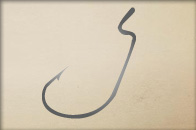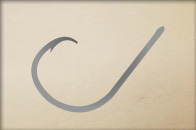Saltwater Fishing Hooks
Saltwater fishing hooks are the unsung heroes of saltwater fishing. So much thought goes into rigs, lures, rods and reels that most take the saltwater fishing hooks for granted when in truth, the rest is meaningless without the right saltwater hooks.
Saltwater Hooks Sizes
Fishing hook size is measured at the gap between the point and the shank. is important to know how to choose fishing hooks, to select the best saltwater fishing hooks for your needs, consider the size and shape of both the bait and the fish. While it may seem intuitive that the best saltwater hooks for fish with small mouths are small hooks, there are situations even when targeting big fish where you still may want to use a small hook. Such as, when using small pieces of bait or live bait, as a larger hook may be difficult to hide in cut bait or could hinder the action of a live bait.
Saltwater fish hook sizes start at a tiny No. 32 and run up to a huge 19/0. From size 32 to 1, saltwater hook size increases while the number decreases. From size 1/0 to 19/0, the hook size increases along with the number. Keep in mind that saltwater hooks are not standardized, thus, one brand’s 3/0 may be larger than that of another brand.
While saltwater fishing hooks come in many sizes and shapes, they are generally made of one of two materials: stainless steel or high-carbon steel. The first is corrosion-resistant but brittle, while the second will rust but is more forgiving of bends and twists. Both require care and maintenance to sustain. Sharpen fishing hooks with a file or hook sharpener and always rinse them with fresh water and coat with light oil between uses to help extend use.
1. J-Hooks
 Fishing bait you will use and the size of the fish that you will target. However, there are a few more challenges when selecting J-hooks. Such as the need to consider that different J-hooks work better with different species of fish. For example, summer flounder anglers prefer Kahle J-hooks because flat fish have a mouth that closes horizontally, while bait fishermen usually choose long-shank saltwater fishing hooks that are easy to remove from a fish’s mouth. Also, some types of J-hooks are specifically designed to work with a specific type of bait. For example, offshore anglers use O’Shaughnessy J-hooks to rig ballyhoo baits.
Fishing bait you will use and the size of the fish that you will target. However, there are a few more challenges when selecting J-hooks. Such as the need to consider that different J-hooks work better with different species of fish. For example, summer flounder anglers prefer Kahle J-hooks because flat fish have a mouth that closes horizontally, while bait fishermen usually choose long-shank saltwater fishing hooks that are easy to remove from a fish’s mouth. Also, some types of J-hooks are specifically designed to work with a specific type of bait. For example, offshore anglers use O’Shaughnessy J-hooks to rig ballyhoo baits.
The width of the fishing hook’s wire is also important. Use beefy hooks for big fish; a thinner wire on delicate baits like shrimp or worms. Hooks for artificial fishing lures are specially designed to work with specific types of lure. Still, you may want to change the factory hooks with a different size or style hook to match your type of fishing. Fishing jigs should have a hook that matches the size of the trailer that you’ll use. When striking a fish with a J-hook, lift the rod tip straight up while reeling in any slack in the line. To avoid deep-hooking a fish (getting the hook down into the fish’s gut or gills rather than just the mouth), set the hook at the slightest tap on the line before the fish has a chance to swallow the bait.
2. Circle Fishing Hooks
 The birth of catch-and-release fishing spawned the invention of circle fishing hooks. These are shaped so that the point turns toward the hook shank, almost making a circle. Circle hooks are mostly used with live or cut fishing bait because the shape of the hook keeps it from becoming lodged in the fish’s gut. As a result, circle saltwater fishing hooks are now considered the best saltwater fishing hooks for catch-and-release fishing.
The birth of catch-and-release fishing spawned the invention of circle fishing hooks. These are shaped so that the point turns toward the hook shank, almost making a circle. Circle hooks are mostly used with live or cut fishing bait because the shape of the hook keeps it from becoming lodged in the fish’s gut. As a result, circle saltwater fishing hooks are now considered the best saltwater fishing hooks for catch-and-release fishing.
When a fish swallows a bait on a circle fishing hook and swims away, the line pulls the hook out of the fish’s stomach and into its mouth, where it will catch in the jaw. Circle hooks are almost foolproof. Instead of jerking the rod to set the hook, simply apply steady pressure until the hook finds its way into the fish’s mouth. Studies have shown that circle hooks dramatically reduce the amount of fish that die after being released. In some fisheries, the use of circle hooks is even required by law. When fishing with natural baits, circle hooks just make sense.
3.Treble Fishing Hooks
.jpg?lang=en-US) Treble saltwater fishing hooks work by snagging the fish when it hits a bait. Treble hooks are sized the same way as other hooks, but it usually takes a smaller treble hook to catch the same size fish as a circle or J-hook. Most plugs use treble hooks so that when the fish realizes it has eaten a lure instead of a real fish, it is already hooked.
Treble saltwater fishing hooks work by snagging the fish when it hits a bait. Treble hooks are sized the same way as other hooks, but it usually takes a smaller treble hook to catch the same size fish as a circle or J-hook. Most plugs use treble hooks so that when the fish realizes it has eaten a lure instead of a real fish, it is already hooked.
Still, many anglers switch treble hooks for J-hooks on their lures to help protect the fish and their fingers. To change out these saltwater hooks, you’ll need a pair of split-ring pliers. Use the finger at the end of the pliers to pry apart the wires on the split-ring, then remove the old hook just like taking a key off a key ring.
To learn about different types of saltwater sinkers visit our next section.
KEEP LEARNING

How to Tie the Non-Slip Loop Knot
The non-slip loop knot is a popular and reliable choice for securing hooks, lures, and other tackle to your fishing line.
LEARN MORE

Socials
Take me fishing social media links
LEARN MORE

TakeMeFishing x Teen Vogue
Join us on a creative journey as fashion designer Ahmrii Johnson walks us through her collaborative vision and process with Teen Vogue and fashion brand, Rentrayage, to create a special piece.
LEARN MORE


.png?lang=en-US&ext=.png)